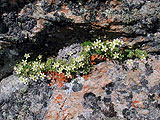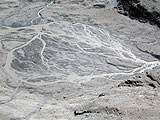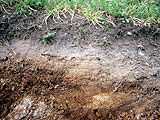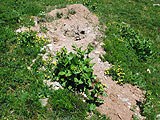 |
|
|
|
|
|
|
1 - Saxifraga bryoides on bare rock |
|
|
2 - Glacier forefield (Wildstrubel glacier, Swiss Alps) 3 - Left: fresh silt deposited from a glacier creek; right: border of an alpine sand dune (near the Pasterze glacier, Grossglockner, Austrian Alps). |
|
|
Alpine plants are commonly not short in mineral nutrients, because of the young age of soils and slope activity (Fig. 4). In old humic soils (Fig. 5) on relatively flat ground in humid climates, leaching (podzolisation, see slope processes and alpine soils) can, however, lead to the loss of essential nutrients. Disturbance of these sites (e.g. by digging a supply line or by ground animal activity, Fig. 6) can create long-lasting visible changes in plant cover (more lush appearance) |
||
|
4 - Fresh mineral nutrients released by natural disturbance. |
5 - Old soils on flat ground may have lost nutrients through leaching. |
6 - Re-vitalisation by disturbance by ground animals (a marmot hole). |
29 August 2011 |
||
| |
||





